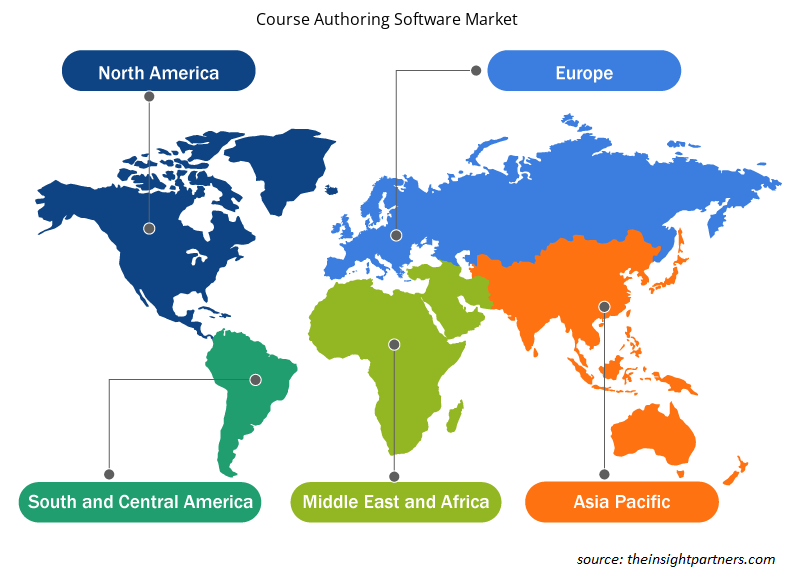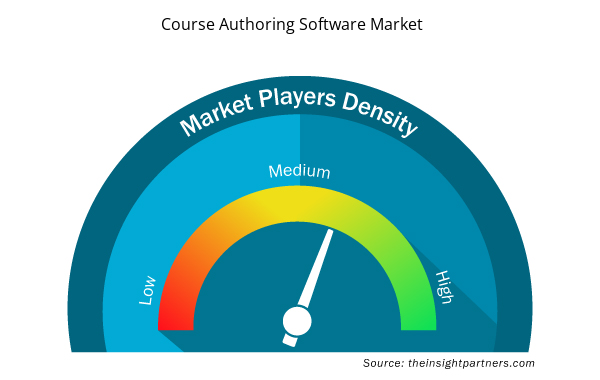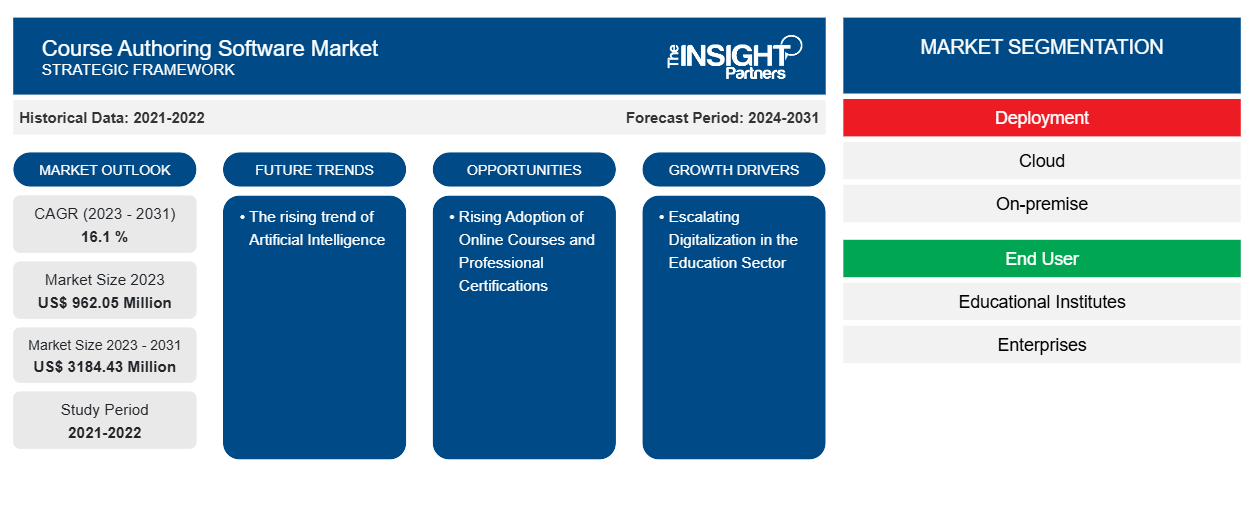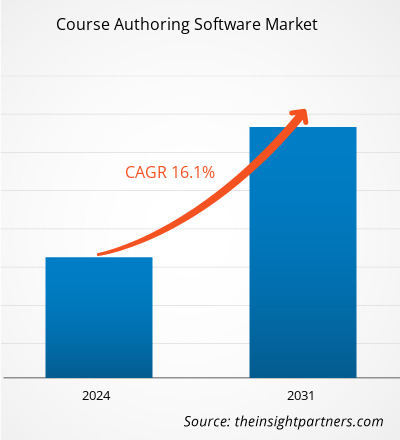Der Markt für Kurserstellungssoftware soll von 962,05 Millionen US-Dollar im Jahr 2023 auf 3.184,43 Millionen US-Dollar im Jahr 2031 anwachsen. Für den Zeitraum 2023–2031 wird für den Markt eine durchschnittliche jährliche Wachstumsrate (CAGR) von 16,1 % erwartet.Der steigende Trend zur künstlichen Intelligenz wird voraussichtlich ein wichtiger Trend auf dem Markt für Kurserstellungssoftware bleiben.
Marktanalyse für Kurserstellungssoftware
Die zunehmende Digitalisierung des Bildungssektors ist ein Faktor, der das Wachstum des Marktes für Kurserstellungssoftware vorantreiben könnte. Kurserstellungssoftware wird im Bildungssektor weithin eingesetzt, um das Lernen und die Ergebnisse zu verbessern. Ed-Tech-Unternehmen, Bildungseinrichtungen und Organisationen verwenden Geräte wie Smartphones , Tablets, VR- und AR-Geräte, digitale interaktive Displays, Smartgeräte und Smartphones zum Zweck des Unterrichts und der Inhaltserstellung. Andere Tools wie virtuelles Lernen, Edutainment, Online-Lernkurse, Online-Bewertungen und digitale Zeitschriften treiben die zunehmende Nutzung digitaler Technologien ebenfalls voran.
Marktübersicht für Kurserstellungssoftware
Ausbilder, Trainer und andere Pädagogen verwenden Kurserstellungssoftware, um Unterrichtsmaterialien zu erstellen, zu organisieren und zu verbreiten. Mithilfe dieses Programms können Benutzer interaktive Kurse und Vorlesungen erstellen, die Text, Grafiken, Fotos, Videos, Audio, Simulationen und Aktivitäten enthalten. Funktionen wie die Verwaltung von Lerninhalten, die Erstellung von Inhalten, Tests und die Überwachung des Lernfortschritts sind häufig ebenfalls in Kurserstellungssoftware enthalten. Die Nachfrage nach effektiven und erschwinglichen Möglichkeiten zur Bereitstellung von Online-Lernen befeuert den Wettbewerb auf dem globalen Markt für Kurserstellungssoftware.
Passen Sie diesen Bericht Ihren Anforderungen an
Sie erhalten kostenlose Anpassungen an jedem Bericht, einschließlich Teilen dieses Berichts oder einer Analyse auf Länderebene, eines Excel-Datenpakets sowie tolle Angebote und Rabatte für Start-ups und Universitäten.
- Holen Sie sich die wichtigsten Markttrends aus diesem Bericht.Dieses KOSTENLOSE Beispiel umfasst eine Datenanalyse von Markttrends bis hin zu Schätzungen und Prognosen.
Markttreiber und Chancen für Kurserstellungssoftware
Zunehmende Digitalisierung im Bildungsbereich
Ausbilder, Trainer und andere Pädagogen nutzen Kurserstellungssoftware, um Unterrichtsmaterialien zu erstellen, zu organisieren und zu verbreiten. Mithilfe dieses Programms können Benutzer interaktive Kurse und Vorlesungen erstellen, die Text, Grafiken, Fotos, Videos, Audio, Simulationen und Aktivitäten enthalten. Funktionen wie die Verwaltung von Lerninhalten, die Erstellung, Prüfung und Überwachung des Lernfortschritts sind häufig ebenfalls in Kurserstellungssoftware enthalten. Die Nachfrage nach effektiven und erschwinglichen Möglichkeiten zur Bereitstellung von Online-Lernen befeuert den Wettbewerb auf dem globalen Markt für Kurserstellungssoftware. Die zunehmende Nutzung mobiler Geräte, der Bedarf an digitalen Lernressourcen, die Verfügbarkeit von Open-Source-Kurserstellungssoftware und die Einführung neuer Technologien wie virtuelle Realität und künstliche Intelligenz sind alles Faktoren, die
Steigende Nutzung von Online-Kursen und professionellen Zertifizierungen
Zu den Vorteilen der Verwendung von Kurserstellungssoftware gehören die Peer-to-Peer-Problemlösung und kostenloses Material. Benutzer können mit Kurserstellungssoftware Inhalte erstellen und zu einer gemeinsamen Lernumgebung hinzufügen. Benutzer können mithilfe einer Vielzahl von Content-Management-Systemen (CMS) Inhalte für eine gemeinsame Lernumgebung erstellen und beitragen. Diese Tools umfassen normalerweise Tools zur Unterstützung bei der Verwaltung von Inhaltsgenehmigungen und -aktualisierungen sowie Vorlagen oder Themen, die Benutzern dabei helfen, eine optisch ansprechende und einheitliche Lernumgebung zu erstellen. Darüber hinaus verfügen viele CMS über soziale Funktionen, mit denen Benutzer gemeinsam an Projekten arbeiten und Inhalte mit anderen Mitgliedern der Community austauschen können. Beliebte Content-Management-Systeme (CMS), die die Kurserstellung unterstützen, sind Moodle, Drupal und WordPress. Daher wird erwartet, dass die zunehmende Einführung von Online-Kursen und professionellen Zertifizierungen den Akteuren auf dem Markt für Kurserstellungssoftware im Prognosezeitraum neue Möglichkeiten bietet.CMS). These tools usually include tools to assist with managing content approvals and updates, as well as templates or themes to assist users in creating a visually appealing and unified learning environment. Furthermore, a lot of CMSs come with social capabilities that let users work together on projects and exchange content with other members of the community. Popular content management systems (CMSs) that support course authoring are Moodle, Drupal, and WordPress. Thus, the rising adoption of online courses and professional certifications is anticipated to present new opportunities for the course authoring software market players during the forecast period.
Marktbericht zur Kurserstellungssoftware – Segmentierungsanalyse
Wichtige Segmente, die zur Ableitung der Marktanalyse für Kurserstellungssoftware beigetragen haben, sind Bereitstellung und Endbenutzer.
- Basierend auf der Bereitstellung ist der Markt für Kurserstellungssoftware in Cloud und On-Premise segmentiert. Das Cloud-Segment hatte im Jahr 2023 einen größeren Marktanteil.
- Nach Endbenutzern ist der Markt in Bildungseinrichtungen und Unternehmen segmentiert.
Marktanteilsanalyse für Kurserstellungssoftware nach geografischer Lage
Der geografische Umfang des Marktberichts zur Kurserstellungssoftware ist hauptsächlich in fünf Regionen unterteilt: Nordamerika, Asien-Pazifik, Europa, Naher Osten und Afrika sowie Südamerika/Süd- und Mittelamerika. In Bezug auf den Umsatz hatte Nordamerika den größten Marktanteil im Bereich der Kurserstellungssoftware. Aufgrund der Existenz von Cloud-Dienstanbietern, Herstellern von Smart-Geräten, Anbietern von Kurserstellungssoftware und anderen Branchenakteuren sowie weit verbreiteter technologischer Fortschritte in diesem Bereich bei Unternehmensorganisationen und Bildungseinrichtungen gab es in Nordamerika einen deutlichen Anstieg des Investitionswachstums für Bildungstechnologiedienste und -lösungen.
Regionale Einblicke in den Markt für Kurserstellungssoftware
Die regionalen Trends und Faktoren, die den Markt für Kurserstellungssoftware während des Prognosezeitraums beeinflussen, wurden von den Analysten von Insight Partners ausführlich erläutert. In diesem Abschnitt werden auch die Marktsegmente und die Geografie von Kurserstellungssoftware in Nordamerika, Europa, im asiatisch-pazifischen Raum, im Nahen Osten und Afrika sowie in Süd- und Mittelamerika erörtert.

- Erhalten Sie regionale Daten zum Markt für Kurserstellungssoftware
Umfang des Marktberichts zur Kurserstellungssoftware
| Berichtsattribut | Details |
|---|---|
| Marktgröße im Jahr 2023 | 962,05 Millionen US-Dollar |
| Marktgröße bis 2031 | 3184,43 Millionen US-Dollar |
| Globale CAGR (2023 - 2031) | 16,1 % |
| Historische Daten | 2021-2022 |
| Prognosezeitraum | 2024–2031 |
| Abgedeckte Segmente | Nach Bereitstellung
|
| Abgedeckte Regionen und Länder | Nordamerika
|
| Marktführer und wichtige Unternehmensprofile |
|
Dichte der Marktteilnehmer für Kurserstellungssoftware: Die Auswirkungen auf die Geschäftsdynamik verstehen
Der Markt für Kurserstellungssoftware wächst rasant, angetrieben durch die steigende Nachfrage der Endnutzer aufgrund von Faktoren wie sich entwickelnden Verbraucherpräferenzen, technologischen Fortschritten und einem größeren Bewusstsein für die Vorteile des Produkts. Mit steigender Nachfrage erweitern Unternehmen ihr Angebot, entwickeln Innovationen, um die Bedürfnisse der Verbraucher zu erfüllen, und nutzen neue Trends, was das Marktwachstum weiter ankurbelt.
Die Marktteilnehmerdichte bezieht sich auf die Verteilung von Firmen oder Unternehmen, die in einem bestimmten Markt oder einer bestimmten Branche tätig sind. Sie gibt an, wie viele Wettbewerber (Marktteilnehmer) in einem bestimmten Marktraum im Verhältnis zu seiner Größe oder seinem gesamten Marktwert präsent sind.
Die wichtigsten auf dem Markt für Kurserstellungssoftware tätigen Unternehmen sind:
- Articulate Global Inc
- Brainshark Inc
- Easygenerator BV
- Erläutern
- iSpring Solutions, Inc
- LearnWorlds (CY) Ltd
Haftungsausschluss : Die oben aufgeführten Unternehmen sind nicht in einer bestimmten Reihenfolge aufgeführt.

- Überblick über die wichtigsten Akteure auf dem Markt für Kurserstellungssoftware
Neuigkeiten und aktuelle Entwicklungen zum Markt für Kurserstellungssoftware
Der Markt für Kurserstellungssoftware wird durch die Erfassung qualitativer und quantitativer Daten nach Primär- und Sekundärforschung bewertet, die wichtige Unternehmensveröffentlichungen, Verbandsdaten und Datenbanken umfasst. Im Folgenden finden Sie eine Liste der Entwicklungen auf dem Markt für Sprach- und Sprechstörungen und -strategien:
- Im März 2022 kündigte Intellum, die führende Bildungsplattform für Kunden, Partner und Mitarbeiter, eine umfassende Neugestaltung von Evolve an, dem weltweit innovativsten Tool zur Inhaltserstellung, das von einer Vielzahl von Unternehmen verwendet wird, darunter Google, Meta, Salesforce, Randstad, Pearson, WeWork und Cotton On. (Quelle: Intellum, Pressemitteilung)
- Im Dezember 2020 kündigte Absorb Software, Anbieter des branchenführenden Absorb Learning Management Systems (LMS), die Veröffentlichung seines neuen Kurserstellungstools Absorb Create an. (Quelle: Absorb Software, Pressemitteilung)
Marktbericht zur Kurserstellungssoftware – Umfang und Ergebnisse
Der Bericht „Marktgröße und Prognose für Kurserstellungssoftware (2021–2031)“ bietet eine detaillierte Analyse des Marktes, die die folgenden Bereiche abdeckt:
- Marktgröße und Prognose auf globaler, regionaler und Länderebene für alle wichtigen Marktsegmente, die im Rahmen des Projekts abgedeckt sind
- Marktdynamik wie Treiber, Beschränkungen und wichtige Chancen
- Wichtige Zukunftstrends
- Detaillierte PEST/Porters Five Forces- und SWOT-Analyse
- Globale und regionale Marktanalyse mit wichtigen Markttrends, wichtigen Akteuren, Vorschriften und aktuellen Marktentwicklungen
- Branchenlandschaft und Wettbewerbsanalyse, einschließlich Marktkonzentration, Heatmap-Analyse, prominenten Akteuren und aktuellen Entwicklungen
- Detaillierte Firmenprofile
- Historische Analyse (2 Jahre), Basisjahr, Prognose (7 Jahre) mit CAGR
- PEST- und SWOT-Analyse
- Marktgröße Wert/Volumen – Global, Regional, Land
- Branche und Wettbewerbsumfeld
- Excel-Datensatz



Report Coverage
Revenue forecast, Company Analysis, Industry landscape, Growth factors, and Trends

Segment Covered
This text is related
to segments covered.

Regional Scope
North America, Europe, Asia Pacific, Middle East & Africa, South & Central America

Country Scope
This text is related
to country scope.
Häufig gestellte Fragen
The global course authoring software market is expected to reach US$ 3184.43 million by 2031.
The key players holding majority shares in the global course authoring software market are Articulate Global Inc., Brainshark Inc., Easygenerator BV, Elucidat, and iSpring Solutions, Inc
The rising trend of Artificial Intelligence is anticipated to play a significant role in the global course authoring software market in the coming years.
The escalating digitalization in the education sector and the rising adoption of online courses and professional certifications are the major factors that propel the global course authoring software market.
The global course authoring software market was estimated to be US$ 962.05 million in 2023 and is expected to grow at a CAGR of 16.1 % during the forecast period 2023 - 2031.
Trends and growth analysis reports related to Technology, Media and Telecommunications : READ MORE..
The Insight Partners performs research in 4 major stages: Data Collection & Secondary Research, Primary Research, Data Analysis and Data Triangulation & Final Review.
- Data Collection and Secondary Research:
As a market research and consulting firm operating from a decade, we have published and advised several client across the globe. First step for any study will start with an assessment of currently available data and insights from existing reports. Further, historical and current market information is collected from Investor Presentations, Annual Reports, SEC Filings, etc., and other information related to company’s performance and market positioning are gathered from Paid Databases (Factiva, Hoovers, and Reuters) and various other publications available in public domain.
Several associations trade associates, technical forums, institutes, societies and organization are accessed to gain technical as well as market related insights through their publications such as research papers, blogs and press releases related to the studies are referred to get cues about the market. Further, white papers, journals, magazines, and other news articles published in last 3 years are scrutinized and analyzed to understand the current market trends.
- Primary Research:
The primarily interview analysis comprise of data obtained from industry participants interview and answers to survey questions gathered by in-house primary team.
For primary research, interviews are conducted with industry experts/CEOs/Marketing Managers/VPs/Subject Matter Experts from both demand and supply side to get a 360-degree view of the market. The primary team conducts several interviews based on the complexity of the markets to understand the various market trends and dynamics which makes research more credible and precise.
A typical research interview fulfils the following functions:
- Provides first-hand information on the market size, market trends, growth trends, competitive landscape, and outlook
- Validates and strengthens in-house secondary research findings
- Develops the analysis team’s expertise and market understanding
Primary research involves email interactions and telephone interviews for each market, category, segment, and sub-segment across geographies. The participants who typically take part in such a process include, but are not limited to:
- Industry participants: VPs, business development managers, market intelligence managers and national sales managers
- Outside experts: Valuation experts, research analysts and key opinion leaders specializing in the electronics and semiconductor industry.
Below is the breakup of our primary respondents by company, designation, and region:

Once we receive the confirmation from primary research sources or primary respondents, we finalize the base year market estimation and forecast the data as per the macroeconomic and microeconomic factors assessed during data collection.
- Data Analysis:
Once data is validated through both secondary as well as primary respondents, we finalize the market estimations by hypothesis formulation and factor analysis at regional and country level.
- Macro-Economic Factor Analysis:
We analyse macroeconomic indicators such the gross domestic product (GDP), increase in the demand for goods and services across industries, technological advancement, regional economic growth, governmental policies, the influence of COVID-19, PEST analysis, and other aspects. This analysis aids in setting benchmarks for various nations/regions and approximating market splits. Additionally, the general trend of the aforementioned components aid in determining the market's development possibilities.
- Country Level Data:
Various factors that are especially aligned to the country are taken into account to determine the market size for a certain area and country, including the presence of vendors, such as headquarters and offices, the country's GDP, demand patterns, and industry growth. To comprehend the market dynamics for the nation, a number of growth variables, inhibitors, application areas, and current market trends are researched. The aforementioned elements aid in determining the country's overall market's growth potential.
- Company Profile:
The “Table of Contents” is formulated by listing and analyzing more than 25 - 30 companies operating in the market ecosystem across geographies. However, we profile only 10 companies as a standard practice in our syndicate reports. These 10 companies comprise leading, emerging, and regional players. Nonetheless, our analysis is not restricted to the 10 listed companies, we also analyze other companies present in the market to develop a holistic view and understand the prevailing trends. The “Company Profiles” section in the report covers key facts, business description, products & services, financial information, SWOT analysis, and key developments. The financial information presented is extracted from the annual reports and official documents of the publicly listed companies. Upon collecting the information for the sections of respective companies, we verify them via various primary sources and then compile the data in respective company profiles. The company level information helps us in deriving the base number as well as in forecasting the market size.
- Developing Base Number:
Aggregation of sales statistics (2020-2022) and macro-economic factor, and other secondary and primary research insights are utilized to arrive at base number and related market shares for 2022. The data gaps are identified in this step and relevant market data is analyzed, collected from paid primary interviews or databases. On finalizing the base year market size, forecasts are developed on the basis of macro-economic, industry and market growth factors and company level analysis.
- Data Triangulation and Final Review:
The market findings and base year market size calculations are validated from supply as well as demand side. Demand side validations are based on macro-economic factor analysis and benchmarks for respective regions and countries. In case of supply side validations, revenues of major companies are estimated (in case not available) based on industry benchmark, approximate number of employees, product portfolio, and primary interviews revenues are gathered. Further revenue from target product/service segment is assessed to avoid overshooting of market statistics. In case of heavy deviations between supply and demand side values, all thes steps are repeated to achieve synchronization.
We follow an iterative model, wherein we share our research findings with Subject Matter Experts (SME’s) and Key Opinion Leaders (KOLs) until consensus view of the market is not formulated – this model negates any drastic deviation in the opinions of experts. Only validated and universally acceptable research findings are quoted in our reports.
We have important check points that we use to validate our research findings – which we call – data triangulation, where we validate the information, we generate from secondary sources with primary interviews and then we re-validate with our internal data bases and Subject matter experts. This comprehensive model enables us to deliver high quality, reliable data in shortest possible time.


 Holen Sie sich ein kostenloses Muster für diesen Bericht
Holen Sie sich ein kostenloses Muster für diesen Bericht